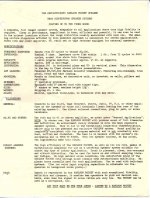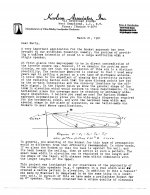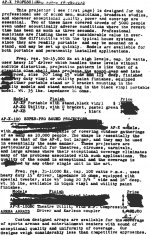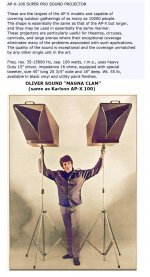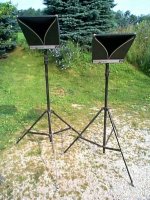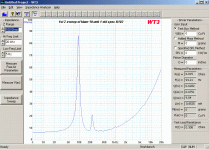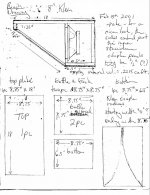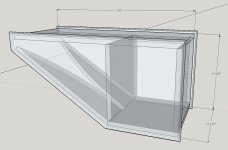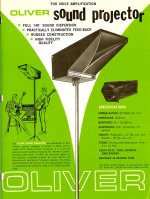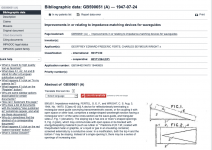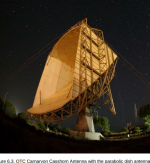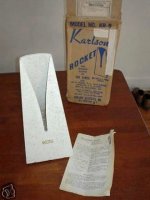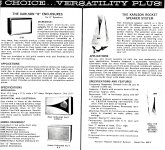NASA consultant John Karlson, his little KR5 "Rocket" and Rise of the Klam projectors
I gather that the little KR5 Rocket speaker had been introduced around 1957,
Somewhere, perhaps lost forever was a KR5 ad touting John Karlson as a NASA consultant.
That is mentioned in this article
Oliver Sound, Inc. | Vintage Guitar(R) magazine
The back of this particular sheet mentions it could be used as a microphone. Martin Poppe mentioned that
John made a set of microphones for Robert Moses - as an abstract representation of the Twin Towers.
In a 1961 letter to the late Martin Poppe (author of the "K-Coupler" as a thesis paper), Mr. Karlson explained the little Rocket speaker, could be rotated and placed high to function with what he believed a "clam" shaped pattern.
That letter presented here, indicates Karlson had built an eight inch driver version.
This led to Karlson's "Asymmetric Projector" series and two twins marketed by Jess Oliver.
Karlson's AP100, I believe, was the same speaker as Oliver's "Magna Clam and assume was scaled 1.5X from Karlson's APX/Oliver Phase III projector. AP100 were installed at Radio City Music Hall and used an Altec 421 plus a compression driver a K-tube.
APX/Phase III and AP100 were vented, with grill cloth covering both their speaker and circular vent. Even the little Rocket had a vent.
Oliver Phase III

Magna Clam / AP100


I gather that the little KR5 Rocket speaker had been introduced around 1957,
Somewhere, perhaps lost forever was a KR5 ad touting John Karlson as a NASA consultant.
That is mentioned in this article
Oliver Sound, Inc. | Vintage Guitar(R) magazine
The back of this particular sheet mentions it could be used as a microphone. Martin Poppe mentioned that
John made a set of microphones for Robert Moses - as an abstract representation of the Twin Towers.
In a 1961 letter to the late Martin Poppe (author of the "K-Coupler" as a thesis paper), Mr. Karlson explained the little Rocket speaker, could be rotated and placed high to function with what he believed a "clam" shaped pattern.
That letter presented here, indicates Karlson had built an eight inch driver version.
This led to Karlson's "Asymmetric Projector" series and two twins marketed by Jess Oliver.
Karlson's AP100, I believe, was the same speaker as Oliver's "Magna Clam and assume was scaled 1.5X from Karlson's APX/Oliver Phase III projector. AP100 were installed at Radio City Music Hall and used an Altec 421 plus a compression driver a K-tube.
APX/Phase III and AP100 were vented, with grill cloth covering both their speaker and circular vent. Even the little Rocket had a vent.
Oliver Phase III

Magna Clam / AP100


Attachments
Last edited:
From what I understand, Karlson installed the AP-X-100 projectors at Radio City Music Hall. One description said it used Altec's 421 woofer plus a compression driver / "K-Tube" tweeter.
Since I cannot find a photograph of AP-X-100, I've used its twin, Jess Oliver's "Magna- Clam" to illustrate and pertainate text from a Karlson projector sheet.
Since I cannot find a photograph of AP-X-100, I've used its twin, Jess Oliver's "Magna- Clam" to illustrate and pertainate text from a Karlson projector sheet.
Attachments
hi TURK 182. my Oliver Phase III has a round hole vent, the little KR5 a small duct and pretty sure AP100 / Magna Clam also have vents - perhaps more as impedance control / pressure relief than useful output (?)
If my rough sketch (sans vent detail 0'm not at home these days) of the Oliver Phase III were scaled ~1.5X, it would pretty much be the size of Karlson's AP100/Magna Clam.
Since the speaker is buried relatively far back compared to the original Karlson, a small klam may have more garble-blee stuff rattling around in its front chamber. My Klam15 sounds very good, A klam 12, good,
My klam 15 sounded "good" up close even without the K-tube extension jammed down its throat.
Karlson type klam playing a bit of Nokie Edwards and Adventure "Autumn Leaves" speaker demo - YouTube
The rough sketch for a klam 8 - its al 3/4" material - I can't draw worth ,,,,. It was quite loud 50 feet away and still pretty good at 150 feet. It ran a Sammi Sound 8 inch fullrange in this old video and overloaded the camera's audio. Up close, although distorted,
one can hear some of the funky ricocheted stuff from the front chamber
karlson projector speaker - YouTube
Maybe I mis-interpreted Carl's notes on that klam 10? - the wings did not place as should. It would need some
front chamber damping to be listenable up close. A good coax will work and its a nice size.
Maybe I can get TB46 to draw something more presentable
If my rough sketch (sans vent detail 0'm not at home these days) of the Oliver Phase III were scaled ~1.5X, it would pretty much be the size of Karlson's AP100/Magna Clam.
Since the speaker is buried relatively far back compared to the original Karlson, a small klam may have more garble-blee stuff rattling around in its front chamber. My Klam15 sounds very good, A klam 12, good,
My klam 15 sounded "good" up close even without the K-tube extension jammed down its throat.
Karlson type klam playing a bit of Nokie Edwards and Adventure "Autumn Leaves" speaker demo - YouTube
The rough sketch for a klam 8 - its al 3/4" material - I can't draw worth ,,,,. It was quite loud 50 feet away and still pretty good at 150 feet. It ran a Sammi Sound 8 inch fullrange in this old video and overloaded the camera's audio. Up close, although distorted,
one can hear some of the funky ricocheted stuff from the front chamber
karlson projector speaker - YouTube
Maybe I mis-interpreted Carl's notes on that klam 10? - the wings did not place as should. It would need some
front chamber damping to be listenable up close. A good coax will work and its a nice size.
Maybe I can get TB46 to draw something more presentable
Attachments
Last edited:
Hi XRK971
I made a teensy klam and loaded it with a Fountek 88 - simply horrible and could have been used as a torture device - perhaps that size would work better as say a PVC pipe slicked diagonally - then fitted with a flat aperture piece.
my long distance K friend Carl Neuser said Karlson's ceiling speaker, AP9C was really good, I once had the old Eminence Beta10cx (with stronger motor than now) in my Phase 3 Oliver klam. Phase 3 had a lot of flex in its particleboard cabinet so strategically braced plywood should be better.
my klam 8 based on Alan Weiss's "Rocket" patio speaker played pretty well with the old Pioneer BOFU. Having sufficient damping material in the rear chamber helped reduce coloration.
I don't know anything about what John Karlson may had done with NASA. Alan Weiss, if still alive probably knows -- perhaps someone posted the story at Job Ulfman's old Karlson speaker forum and Job would know - ??
I made a teensy klam and loaded it with a Fountek 88 - simply horrible and could have been used as a torture device - perhaps that size would work better as say a PVC pipe slicked diagonally - then fitted with a flat aperture piece.
my long distance K friend Carl Neuser said Karlson's ceiling speaker, AP9C was really good, I once had the old Eminence Beta10cx (with stronger motor than now) in my Phase 3 Oliver klam. Phase 3 had a lot of flex in its particleboard cabinet so strategically braced plywood should be better.
my klam 8 based on Alan Weiss's "Rocket" patio speaker played pretty well with the old Pioneer BOFU. Having sufficient damping material in the rear chamber helped reduce coloration.
I don't know anything about what John Karlson may had done with NASA. Alan Weiss, if still alive probably knows -- perhaps someone posted the story at Job Ulfman's old Karlson speaker forum and Job would know - ??
- again a reference to John Karlson being a consultant to NASA on Jess Oliver's Phase 3 Projector sheet.
I once made a phone call to Mr. Oliver - he had high admiration for his late friend John Karlson and said they took one of the Karlson projectors to Yankee Stadium - no deal as neither Jess nor John were good salesmen.
Here's that sheet
I once made a phone call to Mr. Oliver - he had high admiration for his late friend John Karlson and said they took one of the Karlson projectors to Yankee Stadium - no deal as neither Jess nor John were good salesmen.
Here's that sheet
Attachments
hi TURK 182. my Oliver Phase III has a round hole vent, the little KR5 a small duct and pretty sure AP100 / Magna Clam also have vents - perhaps more as impedance control / pressure relief than useful output (?)
Where does the vent go? Exits internally to the K aperture front chamber or a pipe out the back/side?
"Sugar Scoop" Horn
It's basically a form of the high gain "sugar scoop" Cassegrain Horn reflector Satellite Earth Station antenna from e.g. remote Carnarvon in Western Australia from the 1960s.
Horn antenna - Wikipedia
As Karlson says in a Radio interview on YouTube, the aperture does the dispersal, otherwise it would likely be highly directional.
NACA (soon to be NASA) invented the NACA duct or scoop in 1945, the first time I saw Karlsons I thought NASA must have made them....
It's basically a form of the high gain "sugar scoop" Cassegrain Horn reflector Satellite Earth Station antenna from e.g. remote Carnarvon in Western Australia from the 1960s.
Horn antenna - Wikipedia
As Karlson says in a Radio interview on YouTube, the aperture does the dispersal, otherwise it would likely be highly directional.
Karlson patents, inventions, and some related patents (not updated since 2008)
KARLSON PATENTS:
J.E. Karlson US 2586827 “Directive Radiating System” Filed March 31 1945 - a
Parabolic dish microwave antenna with variable directivity pattern
J.E. Karlson “Acoustic Transducers” US 2816619 filed Dec. 1951, granted 6 years later - deals with broad-banding slot both in loudspeakers and musical instruments.
J.E Karlson “Acoustic System” US 2896736 filed Aug. 1955 - use of a modified Karlson laying on its back using either corner or wall to create a diffused sound image - HiFiLit’s website shows a K12 used in this fashion (laid on back) on the 1955 Karlson brochure page and Bose references this K-patent.
J.E. Karlson “Open End Waveguide Antenna” US 3445852 filed 1968 - essentially analogous with the K-tube waveguide used in Karlson’s X15 2-way speaker ~1965.
J.E. Karlson “Acoustic Transducers” - US 3540544 filed 1968 - concurrent with X15 and described Karlson’s use of ellipse based reflectors to improve the Ultra-Fidlety type via
Fig.6 and Fig 8’s reflectors (Fig6 upper reflector was used in the X15) and introduced the Asymmetric Projector with tapered ellipse profile which appeared commercially as the AP-9C ceiling speaker - also- slotted microphones were discussed.
J.E. Karlson “Jet Engine Silencer Nozzle...) US 3543876 filed 1968 - jet engine muffler and rocket nozzles.
LIST OF INVENTIONS 4/24/50
J.E. (Edward) Karlson
1. ELECTRONIC POTENTIOMETER. A variable element which is capable of linear variations of resistances with infinitesimal mechanical motion yet also have capabilities of broad variations in resistance.
2. CAPLESS DISPENSING TUBE. This device permits the use of toothpaste tubes, etc. without the necessity and bother of removing and replacing the cap after each usage.
3. GEOLOGICAL PROSPECTING SYSTEM. A system for use in the prospecting for oil, minerals, etc. This system may also be used for radar applications.
4. RADAR ANTENNA WITH AUTOMATICALLY VARIABLE BEAM PATTERN. This invention provides a simple means of automatically changing the beam pattern of a radar antenna from a pencil beam to a cosecant beam.
5. DIELECTRIC ANTENNA. This invention provides a technique for designing commercial and military antennas which will have overall dimensions than conventional antennae, and yet have equivalent gain and directivity characteristics.
6. BRUSHLESS DC MOTOR
7. ASHTRAY. An extremely simple design for an ash tray which quickly extinguishes cigarettes.
8. PRECISION DELAY CIRCUIT. This circuit provides a delayed pulse at a precise interval following an initial pulse.
9. CHATTERLESS CONTACTS FOR RELAYS
10. TELEVISION ANTENNA. This invention provides a simple, low cost antenna which can be readily hidden or obscured in the average room and is suitable for both F.M. and television.
11. SLOT ANTENNA. This design provides a slot antenna with broad band matching possibilities.
12. HYBRID WAVEGUIDE JUNCTION. This is a wave guide section which has variable propagation characteristics dependent upon the direction of propagation.
13. R.F. TUNER. a simplified tuner for F.M. and television use.
14. ADVERTISING SIGN. Novel electric sigh with quick change possibilities.
15. LIGHT VALVE FOR TELEVISION PROJECTION AND PICKUP TUBE.
16. ACOUSTIC TRANSDUCER. A novel loudspeaker enclosure with improved matching characteristics and controlled reverberation.
17. FISHING DEVICE
18. TELEPHONE AMPLIFIER WITH SPECIAL ACOUSTIC CHARACTERISTICS
SOME RELATED PATENTS:
W.O Swinyard US 2020166 filed 1935 “Sound Reproduction Apparatus” - a wedge-shaped 20 degree chamber with “V” deflector having non-parallel walls -
N.C. Fulmer US 2787332 filed 1952 “Loud-Speaker System” - a folded 1/4 wave pipe with last section broad-banded with tapered slot.
R-J Enclosure:
(1) "The R-J Speaker Enclosure" by William Joseph and Franklin Robbins. Published in Audio Engineering Magazine December 1951.
(2) "Practical Aspects of the R-J Speaker Enclosure" by William Joseph and Franklin Robbins. Published in Audio Engineering Magazine January 1953.
"Acoustic System for Loud-Speaker" US# 2694463; Robbins et al filed April 17, 1952 granted 11/54
(nephew of William) Jeff Joseph's Loudspeakers.
J.J. Baruch US2766839 "Loudspeaker System" Filed March 16th 1953, granted Oct. 16th 1956 - dealt with math of distributive resistive vents using round holes
(Marty Poppe built X15 using 42-0.375" hole vent
John A. McKenzie US 3590941 filed 1969 “Speaker Enclosure” - a dual mouth K-coupler like stacked “Asymmetric-Projector” having a final deflector at each mouth
Robert W. Reams US 4196790 filed 1978 “Acoustic Transducer having Multiple Frequency Resonance” - novel use of Karlson’s slot to create a broad-banded throat in a
PA-application quasi-scoop horn with sealed back chamber.
Rodden, M. Raymond US 4313521 filed Feb. 2 1982 "Speaker Housing"
Sapkowski September 3, 1996 "Exponential multi-ported acoustic enclosure" United States Patent 5,552,569
Weiss et al US 5943431 August 24, 1999 “Loudspeaker With Tapered Slot Coupler And Sound Reproduction System” - basically a wedge-shaped asymmetric projector waveguide for 1” compression driver
KARLSON PATENTS:
J.E. Karlson US 2586827 “Directive Radiating System” Filed March 31 1945 - a
Parabolic dish microwave antenna with variable directivity pattern
J.E. Karlson “Acoustic Transducers” US 2816619 filed Dec. 1951, granted 6 years later - deals with broad-banding slot both in loudspeakers and musical instruments.
J.E Karlson “Acoustic System” US 2896736 filed Aug. 1955 - use of a modified Karlson laying on its back using either corner or wall to create a diffused sound image - HiFiLit’s website shows a K12 used in this fashion (laid on back) on the 1955 Karlson brochure page and Bose references this K-patent.
J.E. Karlson “Open End Waveguide Antenna” US 3445852 filed 1968 - essentially analogous with the K-tube waveguide used in Karlson’s X15 2-way speaker ~1965.
J.E. Karlson “Acoustic Transducers” - US 3540544 filed 1968 - concurrent with X15 and described Karlson’s use of ellipse based reflectors to improve the Ultra-Fidlety type via
Fig.6 and Fig 8’s reflectors (Fig6 upper reflector was used in the X15) and introduced the Asymmetric Projector with tapered ellipse profile which appeared commercially as the AP-9C ceiling speaker - also- slotted microphones were discussed.
J.E. Karlson “Jet Engine Silencer Nozzle...) US 3543876 filed 1968 - jet engine muffler and rocket nozzles.
LIST OF INVENTIONS 4/24/50
J.E. (Edward) Karlson
1. ELECTRONIC POTENTIOMETER. A variable element which is capable of linear variations of resistances with infinitesimal mechanical motion yet also have capabilities of broad variations in resistance.
2. CAPLESS DISPENSING TUBE. This device permits the use of toothpaste tubes, etc. without the necessity and bother of removing and replacing the cap after each usage.
3. GEOLOGICAL PROSPECTING SYSTEM. A system for use in the prospecting for oil, minerals, etc. This system may also be used for radar applications.
4. RADAR ANTENNA WITH AUTOMATICALLY VARIABLE BEAM PATTERN. This invention provides a simple means of automatically changing the beam pattern of a radar antenna from a pencil beam to a cosecant beam.
5. DIELECTRIC ANTENNA. This invention provides a technique for designing commercial and military antennas which will have overall dimensions than conventional antennae, and yet have equivalent gain and directivity characteristics.
6. BRUSHLESS DC MOTOR
7. ASHTRAY. An extremely simple design for an ash tray which quickly extinguishes cigarettes.
8. PRECISION DELAY CIRCUIT. This circuit provides a delayed pulse at a precise interval following an initial pulse.
9. CHATTERLESS CONTACTS FOR RELAYS
10. TELEVISION ANTENNA. This invention provides a simple, low cost antenna which can be readily hidden or obscured in the average room and is suitable for both F.M. and television.
11. SLOT ANTENNA. This design provides a slot antenna with broad band matching possibilities.
12. HYBRID WAVEGUIDE JUNCTION. This is a wave guide section which has variable propagation characteristics dependent upon the direction of propagation.
13. R.F. TUNER. a simplified tuner for F.M. and television use.
14. ADVERTISING SIGN. Novel electric sigh with quick change possibilities.
15. LIGHT VALVE FOR TELEVISION PROJECTION AND PICKUP TUBE.
16. ACOUSTIC TRANSDUCER. A novel loudspeaker enclosure with improved matching characteristics and controlled reverberation.
17. FISHING DEVICE
18. TELEPHONE AMPLIFIER WITH SPECIAL ACOUSTIC CHARACTERISTICS
SOME RELATED PATENTS:
W.O Swinyard US 2020166 filed 1935 “Sound Reproduction Apparatus” - a wedge-shaped 20 degree chamber with “V” deflector having non-parallel walls -
N.C. Fulmer US 2787332 filed 1952 “Loud-Speaker System” - a folded 1/4 wave pipe with last section broad-banded with tapered slot.
R-J Enclosure:
(1) "The R-J Speaker Enclosure" by William Joseph and Franklin Robbins. Published in Audio Engineering Magazine December 1951.
(2) "Practical Aspects of the R-J Speaker Enclosure" by William Joseph and Franklin Robbins. Published in Audio Engineering Magazine January 1953.
"Acoustic System for Loud-Speaker" US# 2694463; Robbins et al filed April 17, 1952 granted 11/54
(nephew of William) Jeff Joseph's Loudspeakers.
J.J. Baruch US2766839 "Loudspeaker System" Filed March 16th 1953, granted Oct. 16th 1956 - dealt with math of distributive resistive vents using round holes
(Marty Poppe built X15 using 42-0.375" hole vent
John A. McKenzie US 3590941 filed 1969 “Speaker Enclosure” - a dual mouth K-coupler like stacked “Asymmetric-Projector” having a final deflector at each mouth
Robert W. Reams US 4196790 filed 1978 “Acoustic Transducer having Multiple Frequency Resonance” - novel use of Karlson’s slot to create a broad-banded throat in a
PA-application quasi-scoop horn with sealed back chamber.
Rodden, M. Raymond US 4313521 filed Feb. 2 1982 "Speaker Housing"
Sapkowski September 3, 1996 "Exponential multi-ported acoustic enclosure" United States Patent 5,552,569
Weiss et al US 5943431 August 24, 1999 “Loudspeaker With Tapered Slot Coupler And Sound Reproduction System” - basically a wedge-shaped asymmetric projector waveguide for 1” compression driver
Here's the only picture I can find anymore of the Karlson KR5 speaker. It weighed around 2.5 pounds. The 5 inch frame speaker had had a 3oz ferrite magnet and a resonance of 160 c.p.s. - there was a note somewhere (perhaps from Martin Poppe) that Karlson treated those paper surrounds with polysorbate 80.
It was quite attractively finished with gold specks in a pearl white paint and impressive joinery for thin plywood.
Sorry for the poor resolution
A note to me from the late Martin Poppe
" -- Freddy,
I do not have any Rocket information. ......
The best I can do with the Rocket is to guess based on size. The walls were thin, 3/8 to 1/2" material, a dense plywood finished with a spackle (?)
paint finish? The base was about 6 x 6, just big enough inside to accommodate the width of the speaker. Height maybe 14 to 16" The front and the back met at a point (say 1/2 the wood thickness), side to side width at
the top was about 4", the max opening of the taper.
The speaker was tilted toward the front at an angle of about 30 deg and maybe 2" off the base in the front (and higher in the back because of the 30 deg tilt (as I recall,
the back of the speaker just about fit in the bottom) . A damping material was stuffed behind the speaker. The taper started from a 1/4 - 3/8" radius
( a hole before the taper was cut) the opening taper is smooth, having the Karlson look. If you have a data sheet, you can probably crisp up the dimensions.
If I were experimenting, I would not close the front to the back at a point at the top, but leave a gap of about 1 1/2 to 2" to let the sound out of the end, much like the K-Coupler of my thesis and the side to side sketch I sent
to you sometime ago.
Marty
Martin Carl Poppe
CAMBRIDGE ENGINEERING, Inc.
http://www.cameng.com/"
It was quite attractively finished with gold specks in a pearl white paint and impressive joinery for thin plywood.
Sorry for the poor resolution
A note to me from the late Martin Poppe
" -- Freddy,
I do not have any Rocket information. ......
The best I can do with the Rocket is to guess based on size. The walls were thin, 3/8 to 1/2" material, a dense plywood finished with a spackle (?)
paint finish? The base was about 6 x 6, just big enough inside to accommodate the width of the speaker. Height maybe 14 to 16" The front and the back met at a point (say 1/2 the wood thickness), side to side width at
the top was about 4", the max opening of the taper.
The speaker was tilted toward the front at an angle of about 30 deg and maybe 2" off the base in the front (and higher in the back because of the 30 deg tilt (as I recall,
the back of the speaker just about fit in the bottom) . A damping material was stuffed behind the speaker. The taper started from a 1/4 - 3/8" radius
( a hole before the taper was cut) the opening taper is smooth, having the Karlson look. If you have a data sheet, you can probably crisp up the dimensions.
If I were experimenting, I would not close the front to the back at a point at the top, but leave a gap of about 1 1/2 to 2" to let the sound out of the end, much like the K-Coupler of my thesis and the side to side sketch I sent
to you sometime ago.
Marty
Martin Carl Poppe
CAMBRIDGE ENGINEERING, Inc.
http://www.cameng.com/"
Attachments
Last edited:
I don't understand Marty's wording, I can't visualize his description.
This may help;
karlson rocket 1970 calcul plan ( supravox, enceinte acoustique facile ,plan, Speaker) - YouTube
This may help;
karlson rocket 1970 calcul plan ( supravox, enceinte acoustique facile ,plan, Speaker) - YouTube
Last edited:
that confuses me somewhat. I know Carl Neuser built little Rocket type for Polk coaxial using 6 degree tapers as viewed from the front and 12 degree tapers as viewed from the side. With a centered dome on a coax speaker, a K-tube could be attached to pipe the highs out to the main aperture area, thus relieving them from the influence of being buried and bouncing around in the front chamber
With a modern speaker having better high frequency power response than the original radio type speaker, a little Rocket might play OK.
Carl and his son built a 6.5" driver version - I think with a Polk coax and K-tube - over a telephone, I could tell it kicked on percussion. Also, a decent 6.5" coax like Polk DB675 could play alright in K8 with vents sealed, or klam 8,
With a modern speaker having better high frequency power response than the original radio type speaker, a little Rocket might play OK.
Carl and his son built a 6.5" driver version - I think with a Polk coax and K-tube - over a telephone, I could tell it kicked on percussion. Also, a decent 6.5" coax like Polk DB675 could play alright in K8 with vents sealed, or klam 8,
Attachments
- Home
- Loudspeakers
- Full Range
- NASA consultant John Karlson, his little KR5 "Rocket" and Rise of the Klam projectors

